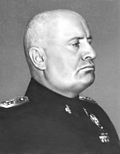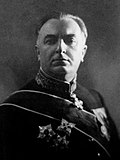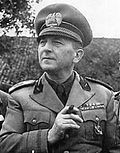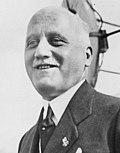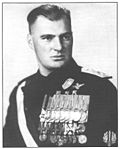Top Qs
Timeline
Chat
Perspective
Grand Council of Fascism
Central body of the government of Fascist Italy from 1928 to 1943 From Wikipedia, the free encyclopedia
Remove ads
The Grand Council of Fascism (Italian: Gran Consiglio del Fascismo, also translated "Fascist Grand Council") was the main body of Mussolini's government in Fascist Italy, which held and applied great power to control the institutions of government. It was created as a body of the National Fascist Party in 1922, and became a state body on 9 December 1928. The council usually met at the Palazzo Venezia, Rome, which was also the seat of the head of the Italian government.[1] The Council became extinct following a series of events in 1943, in which Benito Mussolini was voted out as the Prime Minister of Italy.
You can help expand this article with text translated from the corresponding article in Italian. (December 2011) Click [show] for important translation instructions.
|
Remove ads
Powers of the Council
Summarize
Perspective

Essentially, the council held these powers:
- The power to elect the Fascist Party deputies, the nomination for the Party Secretary and other party leaders, the approval of the party statutes and the power regarding the party's policy.
- The power to elect the Crown's line of succession including the choice of the heir to the throne, the right of the Crown, the power to choose possible successors to the Prime Minister, the power to choose the function and membership of the Grand Council, the Senate, the Chamber of Deputies (later the Chamber of Fasces and Corporations), the power to decide the rights and powers of the Prime Minister, international Treaties, and foreign affairs.
The Grand Council meetings were convened by the Prime Minister himself, and all decrees and laws could only be legalized after receiving his approval. In contrast to the Führerprinzip government model in Nazi Germany, the Grand Council retained the power to recommend that the King of Italy remove the Prime Minister from office. As all the former governing institutions had been subordinated to the Fascist Party, the Council was the only check on Mussolini's power.
Remove ads
Overthrow of Mussolini
Summarize
Perspective
The Allies invaded Sicily in July 1943. Grand Council member Dino Grandi proposed a vote of no confidence in Mussolini as leader of the Council and the party. A vote was held on the night of 24–25 July 1943 and passed with 19 votes for, 8 against and one abstention. Among the 19 votes of no confidence were those of Mussolini's son-in-law Galeazzo Ciano, who had been former minister of foreign affairs, and the influential marshal Emilio De Bono.
The following day King Victor Emmanuel met Mussolini and informed him that General Pietro Badoglio would lead Italy, as Prime Minister. Mussolini was arrested immediately after the meeting.[2]
In September 1943 Mussolini was freed from imprisonment by German commandos and helped to regain power in northern Italy. He had those who voted against him tried for treason at the Verona trial. All of them were found guilty, with all but one of them being sentenced to death. However, only Giovanni Marinelli, Carlo Pareschi, Luciano Gottardi, Ciano, De Bono, and Tullio Cianetti, were physically present for the trial. With the exception of Cianetti, those present were all executed by firing squad on the morning of 11 January 1944.[3][4]
Remove ads
Members of the Council
Summarize
Perspective
The composition of the Council was revised and defined by a law of 14 December 1929 and became a state body from 9 December 1928. Its members, selected among the party's gerarchi, are below. Their vote on the 25 July 1943 motion to depose Mussolini is also given next to their name.
President of the Council
Quadrumvirs
Parliament
Positions in the Cabinet
Royal Academy of Italy
Special Court for the Defence of the State
Secretary of the Party
Other posts
- The Presidents of the Corporations: Industrialists, Farmers, Industrial Workers, Agriculture Workers.
Chief of Staff of the MVSN
Officeholders who held appointments of a three-year duration
Remove ads
See also
- Italian Fascism
- Italian Parliament (1928–1939)
- Movimiento Nacional, governing body of Francoist Spain
Notes
References
Further reading
Wikiwand - on
Seamless Wikipedia browsing. On steroids.
Remove ads


